Evaluating Surface Properties and Cellular Responses to Surface-Treated Different Triple Periodic Minimal Surface L-PBF Ti6Al4V Lattices for Biomedical Devices
Abstract
1. Introduction
2. Results
2.1. Surface Topography and Surface Energy
2.2. Cell Proliferation of Human Osteoblasts
2.3. Cell Attachment of Human Osteoblasts and HUVECs
2.4. Gene Expression of HUVECs
2.5. Osteogenic Differentiation Assay
2.6. Inflammatory Response
2.7. Scanning Electron Microscopy
3. Discussion
4. Materials and Methods
4.1. Preparation of Titanium Lattices
4.2. Analysis of Surface Chemistry
- γtotal: the total surface energy
- γdispersive: the dispersive (van der Waals) component of the surface energy
- γpolar: the polar component of the surface energy
4.3. Isolation and Cultivation of Human Osteoblasts
4.4. Cell Culture of Human Umbilical Vein Endothelial Cells
4.5. Cell Culture of Human Monocyte Cells
4.6. Proliferation and Cell Attachment Assays
4.7. Angiogenesis Assay
4.8. Osteogenic Differentiation Assay
4.8.1. Alkaline Phosphatase (ALP) Activity Assay
4.8.2. Alizarin Red S
4.9. Gene Expression of Inflammatory Markers
4.10. Scanning Electron Microscopy
4.11. Statistical Analysis
5. Conclusions
- The surface chemistry of titanium lattice could be impacted by post-surface treatment, which influences cell differentiation and proliferation.
- The increase in cell proliferation was not affected by lattice design but could be enhanced by the post-surface treatment using chemical etching.
- Neither mineralization nor angiogenesis was influenced by lattice design and post-surface treatment.
- The L-PBF titanium lattice had a noticeable effect on the inflammatory response. The inflammatory response would also be influenced by the surface chemistry of printed titanium lattice.
Author Contributions
Funding
Institutional Review Board Statement
Informed Consent Statement
Data Availability Statement
Acknowledgments
Conflicts of Interest
References
- Gibson, L.J.; Ashby, M.F. Cellular Solids: Structure and Properties, 2nd ed.; Cambridge University Press: Cambridge, UK, 1999. [Google Scholar]
- Lewis, G. Properties of open-cell porous metals and alloys for orthopaedic applications. J. Mater. Sci. Mater. Med. 2013, 24, 2293–2325. [Google Scholar] [CrossRef] [PubMed]
- Suresh, S.; Sun, C.N.; Tekumalla, S.; Rosa, V.; Nai, S.M.L.; Wong, R.C.W. Mechanical properties and in vitro cytocompatibility of dense and porous Ti-6Al-4V ELI manufactured by selective laser melting technology for biomedical applications. J. Mech. Behav. Biomed. Mater. 2021, 123, 104712. [Google Scholar] [CrossRef] [PubMed]
- Yılmaz, E.; Gökçe, A.; Findik, F.; Gülsoy, H.Ö.; İyibilgin, O. Mechanical properties and electrochemical behavior of porous Ti-Nb biomaterials. J. Mech. Behav. Biomed. Mater. 2018, 87, 59–67. [Google Scholar]
- Bencharit, S.; Byrd, W.C.; Altarawneh, S.; Hosseini, B.; Leong, A.; Reside, G.; Morelli, T.; Offenbacher, S. Porous Tantalum Trabecular Metal Dental Implants. Clin. Implant. Dent. Relat. Res. 2014, 16, 817–826. [Google Scholar] [PubMed]
- Murr, L.E.; Gaytan, S.M.; Medina, F.; Lopez, H.; Martinez, E.; Machado, B.I.; Hernandez, D.H.; Martinez, L.; Lopez, M.I.; Wicker, R.B.; et al. Next-generation biomedical implants using additive manufacturing of complex, cellular and functional mesh arrays. Philos. Trans. A Math. Phys. Eng. Sci. 2010, 368, 1999–2032. [Google Scholar]
- Oh, I.-H.; Nomura, N.; Masahashi, N.; Hanada, S. Mechanical properties of porous titanium compacts prepared by powder sintering. Scr. Mater. 2003, 49, 1197–1202. [Google Scholar] [CrossRef]
- Chen, Z.; Yan, X.; Yin, S.; Liu, L.; Liu, X.; Zhao, G.; Ma, W.; Qi, W.; Ren, Z.; Liao, H.; et al. Influence of the pore size and porosity of selective laser melted Ti6Al4V ELI porous scaffold on cell proliferation, osteogenesis and bone ingrowth. Mater. Sci. Eng. C Mater. Biol. Appl. 2020, 106, 110289. [Google Scholar]
- Wang, X.; Xu, S.; Zhou, S.; Xu, W.; Leary, M.; Choong, P.; Qian, M.; Brandt, M.; Xie, Y.M. Topological design and additive manufacturing of porous metals for bone scaffolds and orthopaedic implants: A review. Biomaterials 2016, 83, 127–141. [Google Scholar]
- Warnke, P.H.; Douglas, T.; Wollny, P.; Sherry, E.; Steiner, M.; Galonska, S.; Becker, S.T.; Springer, I.N.; Wiltfang, J.; Sivananthan, S. Rapid prototyping: Porous titanium alloy scaffolds produced by selective laser melting for bone tissue engineering. Tissue Eng. Part C Methods 2009, 15, 115–124. [Google Scholar] [CrossRef]
- Taniguchi, N.; Fujibayashi, S.; Takemoto, M.; Sasaki, K.; Otsuki, B.; Nakamura, T.; Matsushita, T.; Kokubo, T.; Matsuda, S. Effect of pore size on bone ingrowth into porous titanium implants fabricated by additive manufacturing: An in vivo experiment. Mater. Sci. Eng. C Mater. Biol. Appl. 2016, 59, 690–701. [Google Scholar] [CrossRef]
- Markhoff, J.; Wieding, J.; Weissmann, V.; Pasold, J.; Jonitz-Heincke, A.; Bader, R. Influence of Different Three-Dimensional Open Porous Titanium Scaffold Designs on Human Osteoblasts Behavior in Static and Dynamic Cell Investigations. Materials 2015, 8, 5490–5507. [Google Scholar] [CrossRef] [PubMed]
- Seehanam, S.; Khrueaduangkham, S.; Sinthuvanich, C.; Sae-Ueng, U.; Srimaneepong, V.; Promoppatum, P. Evaluating the effect of pore size for 3d-printed bone scaffolds. Heliyon 2024, 10, e26005. [Google Scholar] [CrossRef] [PubMed]
- Song, P.; Hu, C.; Pei, X.; Sun, J.; Sun, H.; Wu, L.; Jiang, Q.; Fan, H.; Yang, B.; Zhou, C.; et al. Dual modulation of crystallinity and macro-/microstructures of 3D printed porous titanium implants to enhance stability and osseointegration. J. Mater. Chem. B 2019, 7, 2865–2877. [Google Scholar] [PubMed]
- Tang, J.; Luo, J.; Huang, Y.; Sun, J.; Zhu, Z.; Xu, J.; Dargusch, M.; Yan, M. Immunological response triggered by metallic 3D printing powders. Addit. Manuf. 2020, 35, 101392. [Google Scholar]
- Distefano, F.; Pasta, S.; Epasto, G. Titanium Lattice Structures Produced via Additive Manufacturing for a Bone Scaffold: A Review. J. Funct. Biomater. 2023, 14, 125. [Google Scholar] [CrossRef]
- Miao, X.; Sun, D. Graded/Gradient Porous Biomaterials. Materials 2010, 3, 26–47. [Google Scholar]
- Pałka, K.; Pokrowiecki, R. Porous Titanium Implants: A Review. Adv. Eng. Mater. 2018, 20, 1700648. [Google Scholar]
- Wang, N.; Meenashisundaram, G.K.; Kandilya, D.; Fuh, J.Y.H.; Dheen, S.T.; Kumar, A.S. A biomechanical evaluation on Cubic, Octet, and TPMS gyroid Ti6Al4V lattice structures fabricated by selective laser melting and the effects of their debris on human osteoblast-like cells. Biomater. Adv. 2022, 137, 212829. [Google Scholar]
- Yan, C.; Hao, L.; Hussein, A.; Young, P. Ti–6Al–4V triply periodic minimal surface structures for bone implants fabricated via selective laser melting. J. Mech. Behav. Biomed. Mater. 2015, 51, 61–73. [Google Scholar] [CrossRef]
- Yang, Y.; Xu, T.; Bei, H.-P.; Zhang, L.; Tang, C.-Y.; Zhang, M.; Xu, C.; Bian, L.; Yeung, K.W.-K.; Fuh, J.Y.H.; et al. Gaussian curvature–driven direction of cell fate toward osteogenesis with triply periodic minimal surface scaffolds. Proc. Natl. Acad. Sci. USA 2022, 119, e2206684119. [Google Scholar]
- Piglionico, S.; Bousquet, J.; Fatima, N.; Renaud, M.; Collart-Dutilleul, P.-Y.; Bousquet, P. Porous Tantalum vs. Titanium Implants: Enhanced Mineralized Matrix Formation after Stem Cells Proliferation and Differentiation. J. Clin. Med. 2020, 9, 3657. [Google Scholar] [CrossRef]
- Hashmi, A.W.; Mali, H.S.; Meena, A. A comprehensive review on surface quality improvement methods for additively manufactured parts. Rapid Prototyp. J. 2022, 29, 504–557. [Google Scholar]
- Strano, G.; Hao, L.; Everson, R.M.; Evans, K.E. Surface roughness analysis, modelling and prediction in selective laser melting. J. Mater. Process. Technol. 2013, 213, 589–597. [Google Scholar]
- Bagherifard, S.; Guagliano, M. 12—Post-processing. In Fundamentals of Laser Powder Bed Fusion of Metals; Yadroitsev, I., Yadroitsava, I., Plessis, A.D., MacDonald, E., Eds.; Elsevier: Amsterdam, The Netherlands, 2021; pp. 327–348. [Google Scholar]
- Raines, A.L.; Olivares-Navarrete, R.; Wieland, M.; Cochran, D.L.; Schwartz, Z.; Boyan, B.D. Regulation of angiogenesis during osseointegration by titanium surface microstructure and energy. Biomaterials 2010, 31, 4909–4917. [Google Scholar] [PubMed]
- Tang, J.; Sang, Z.; Zhang, X.; Song, C.; Tang, W.; Luo, X.; Yan, M. Impacts of residual 3D printing metal powders on immunological response and bone regeneration: An in vivo study. J. Mater. Sci. Mater. Med. 2023, 34, 29. [Google Scholar]
- Bezuidenhout, M.; Ter Haar, G.; Becker, T.; Rudolph, S.; Damm, O.; Sacks, N. The effect of HF-HNO3 chemical polishing on the surface roughness and fatigue life of laser powder bed fusion produced Ti6Al4V. Mater. Today Commun. 2020, 25, 101396. [Google Scholar] [CrossRef]
- Wysocki, B.; Idaszek, J.; Buhagiar, J.; Szlązak, K.; Brynk, T.; Kurzydłowski, K.J.; Święszkowski, W. The influence of chemical polishing of titanium scaffolds on their mechanical strength and in-vitro cell response. Mater. Sci. Eng. C Mater. Biol. Appl. 2018, 95, 428–439. [Google Scholar]


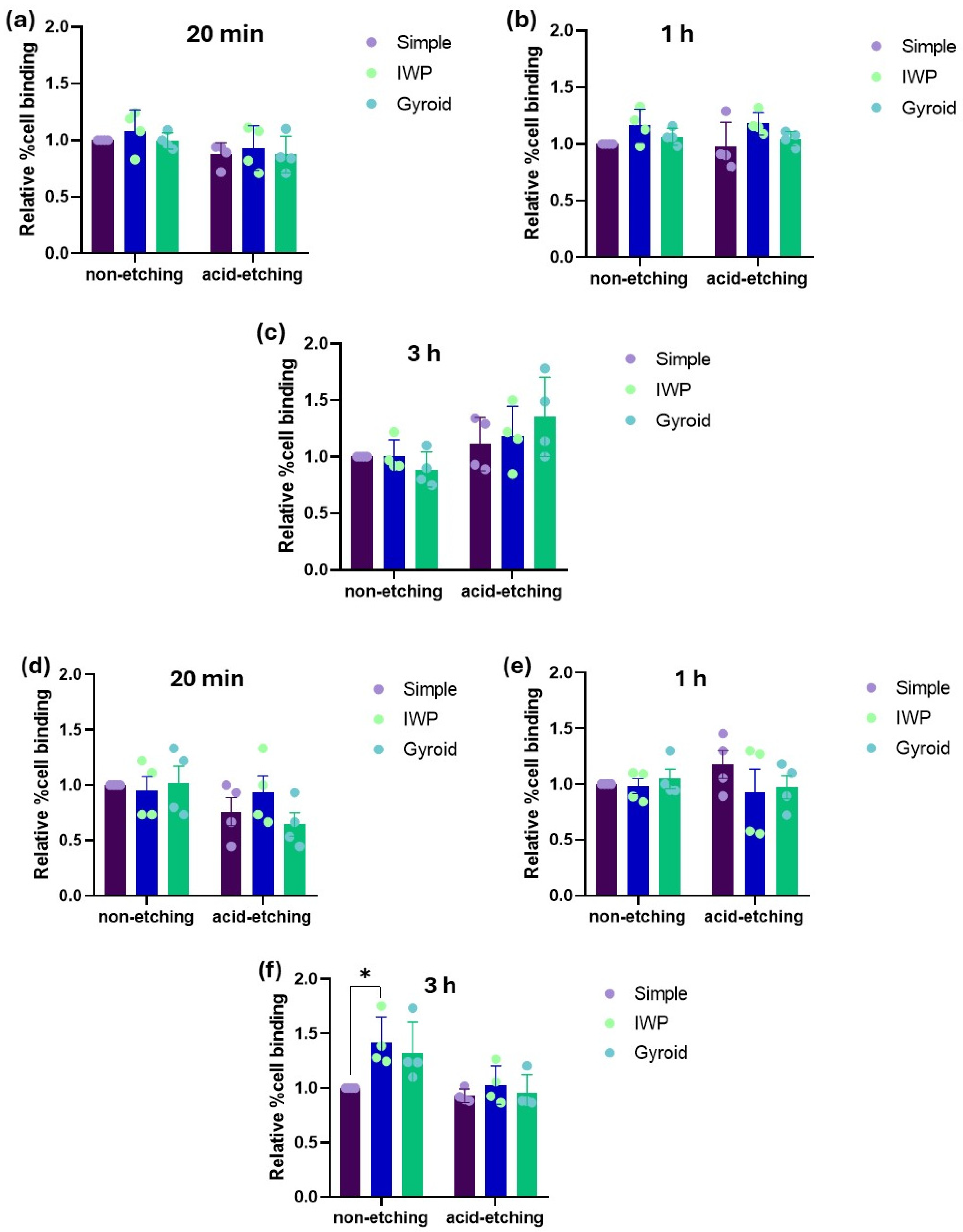
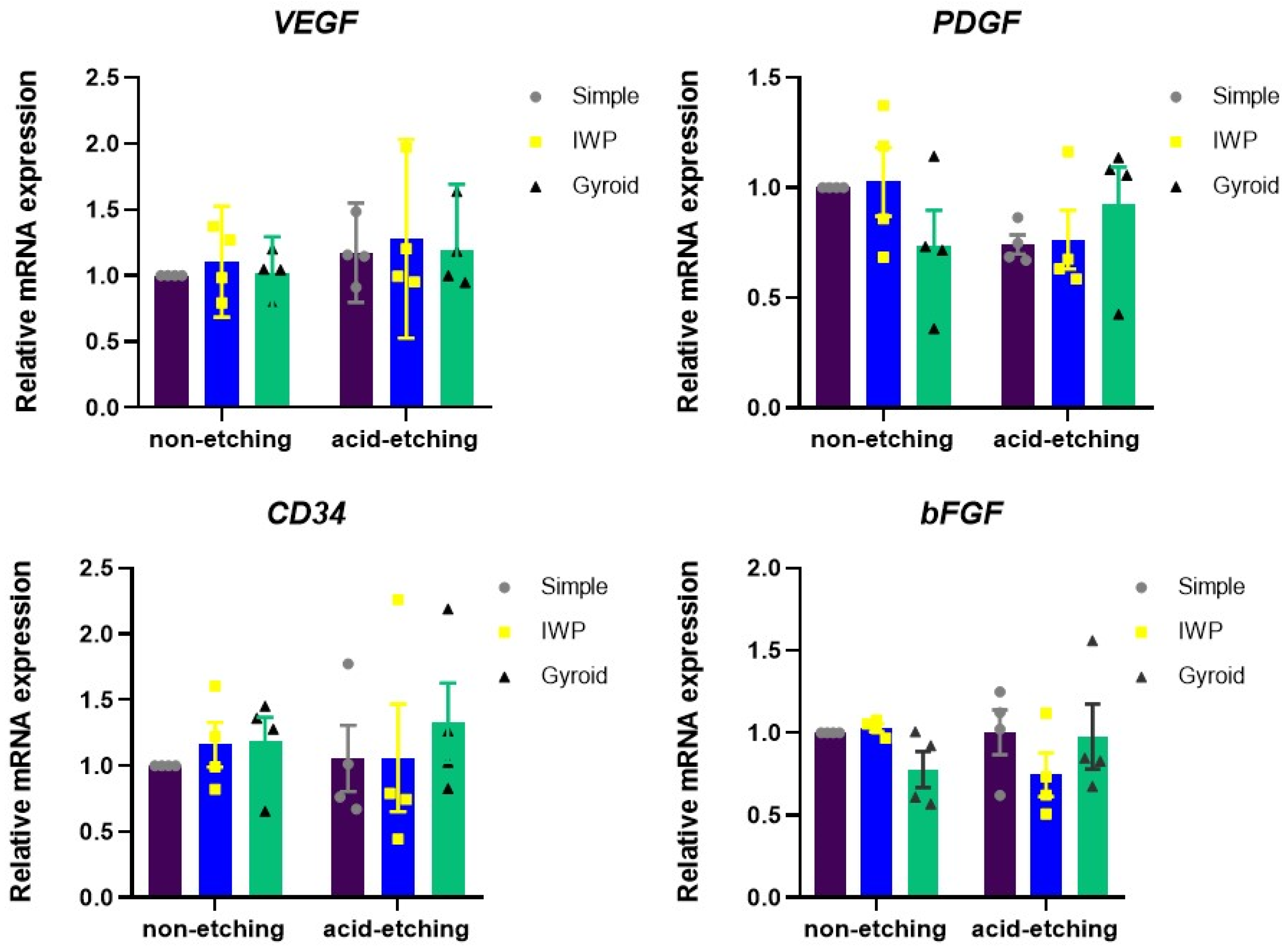
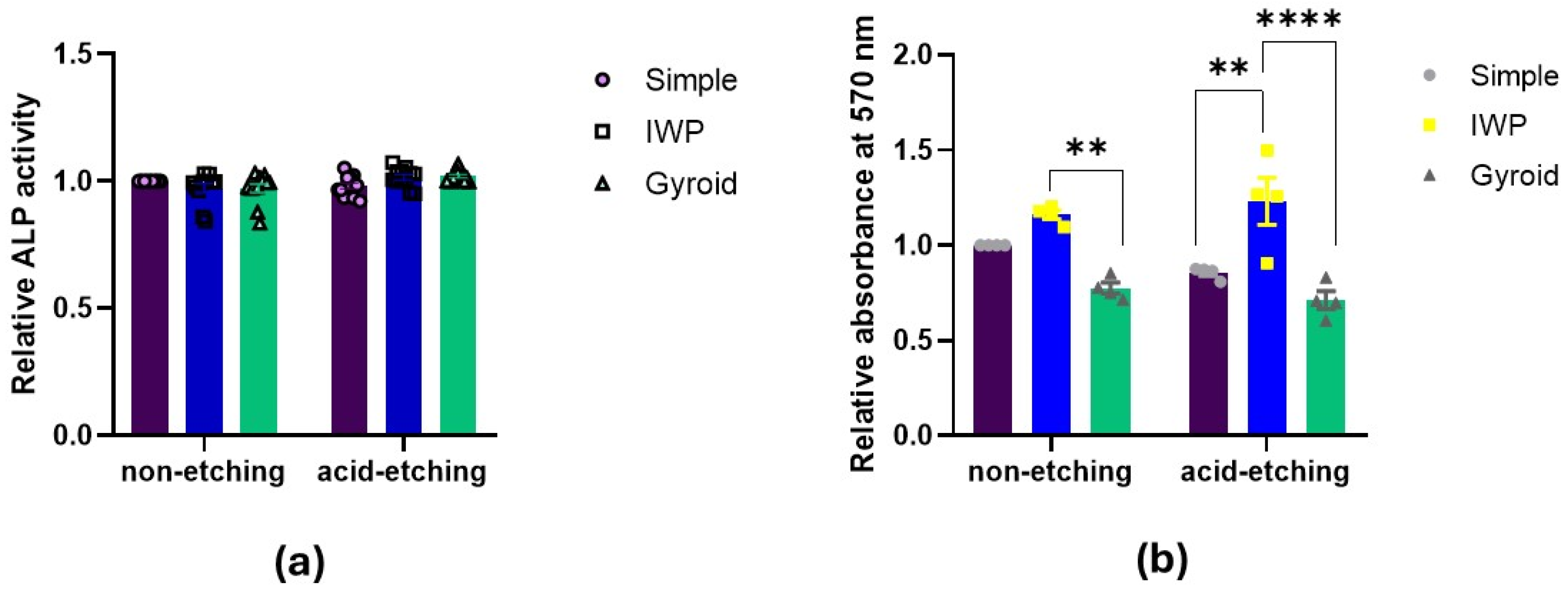
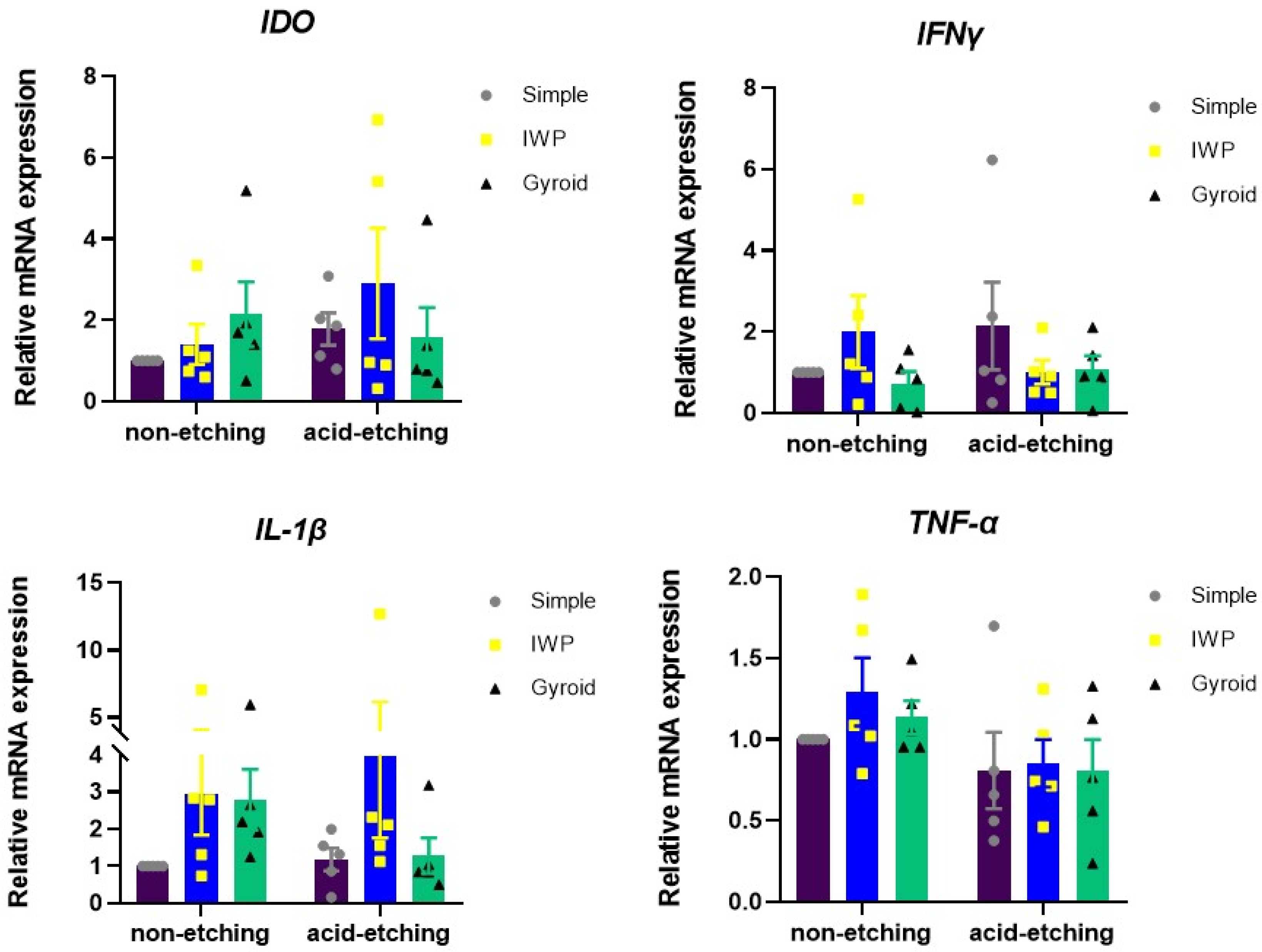
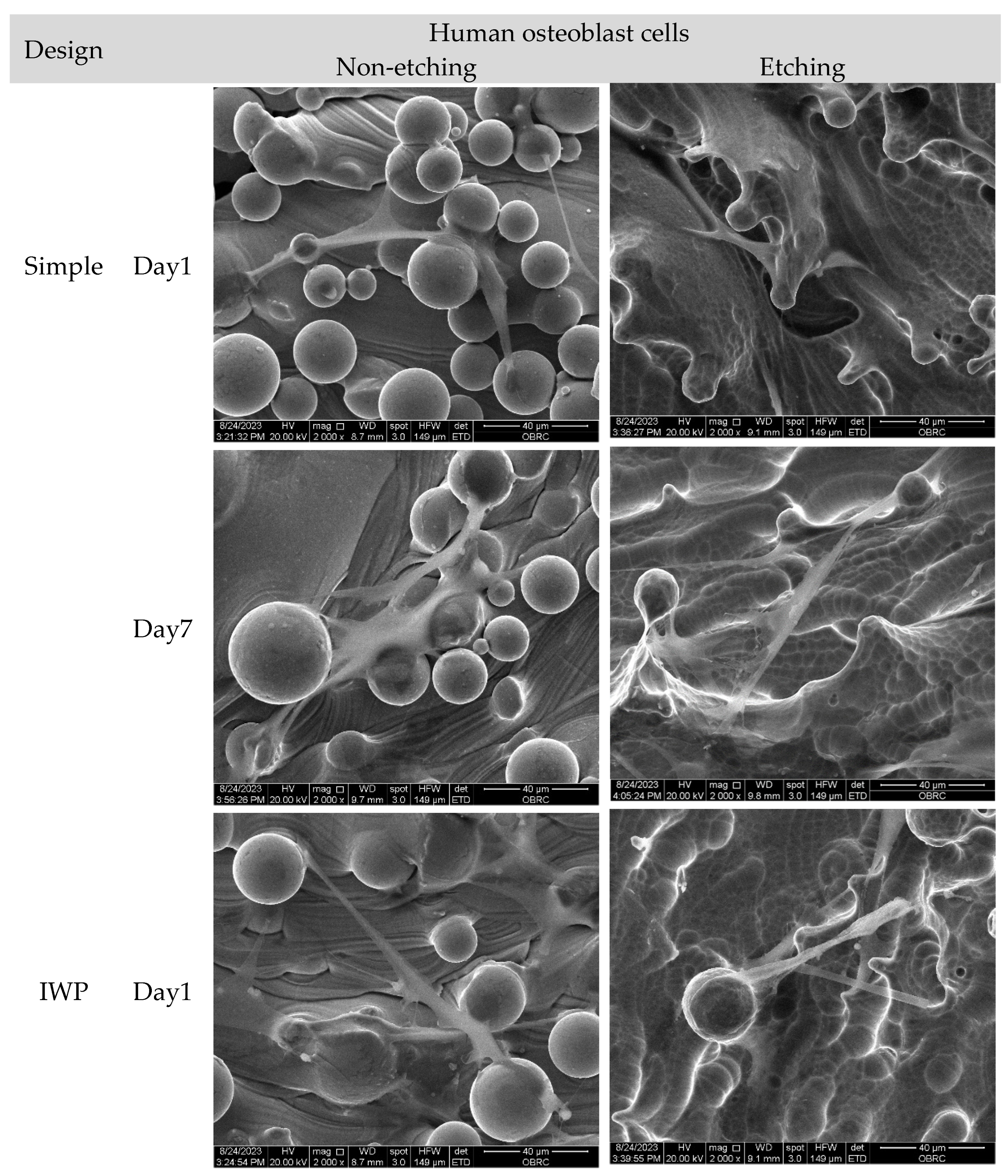
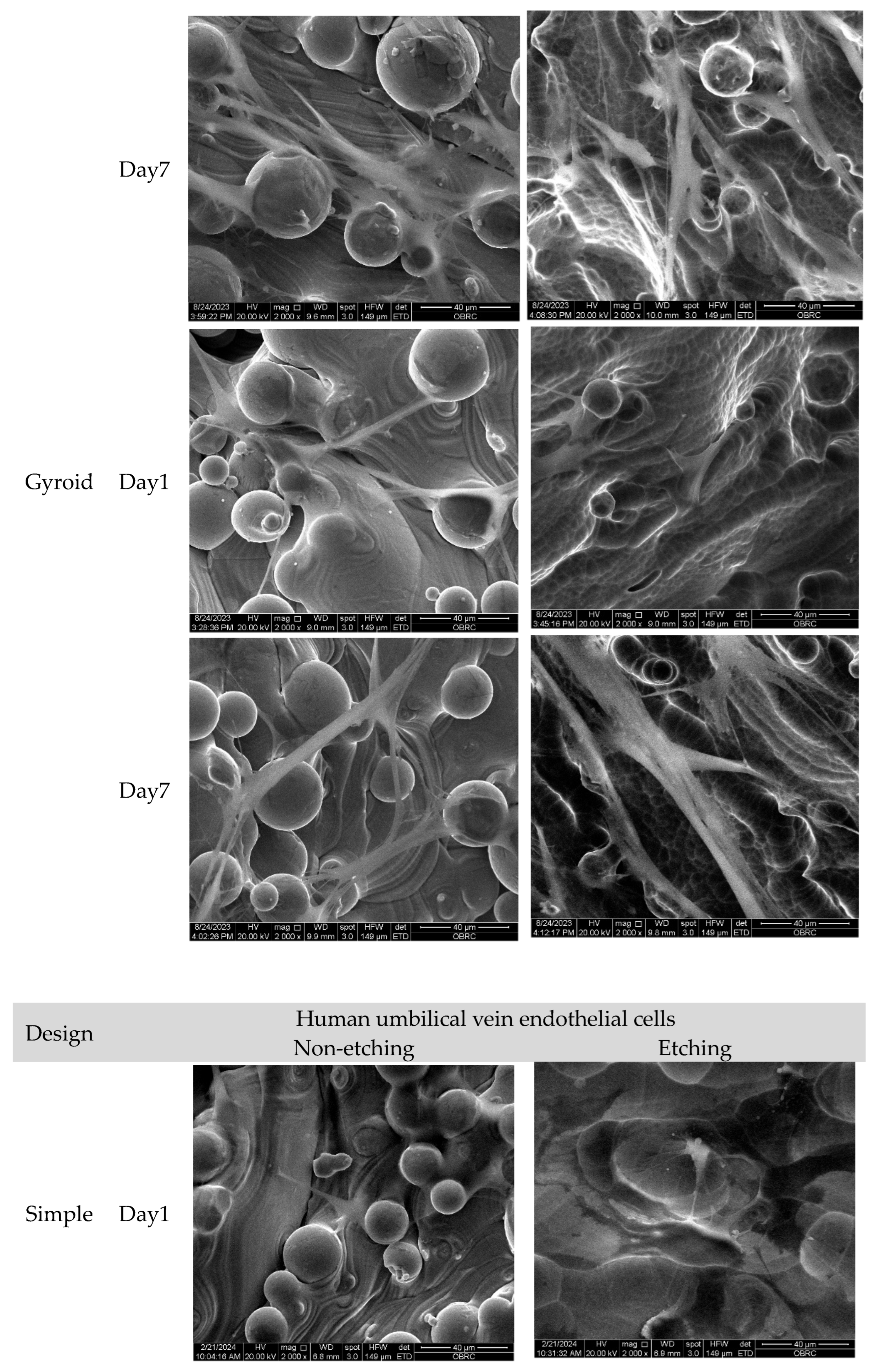
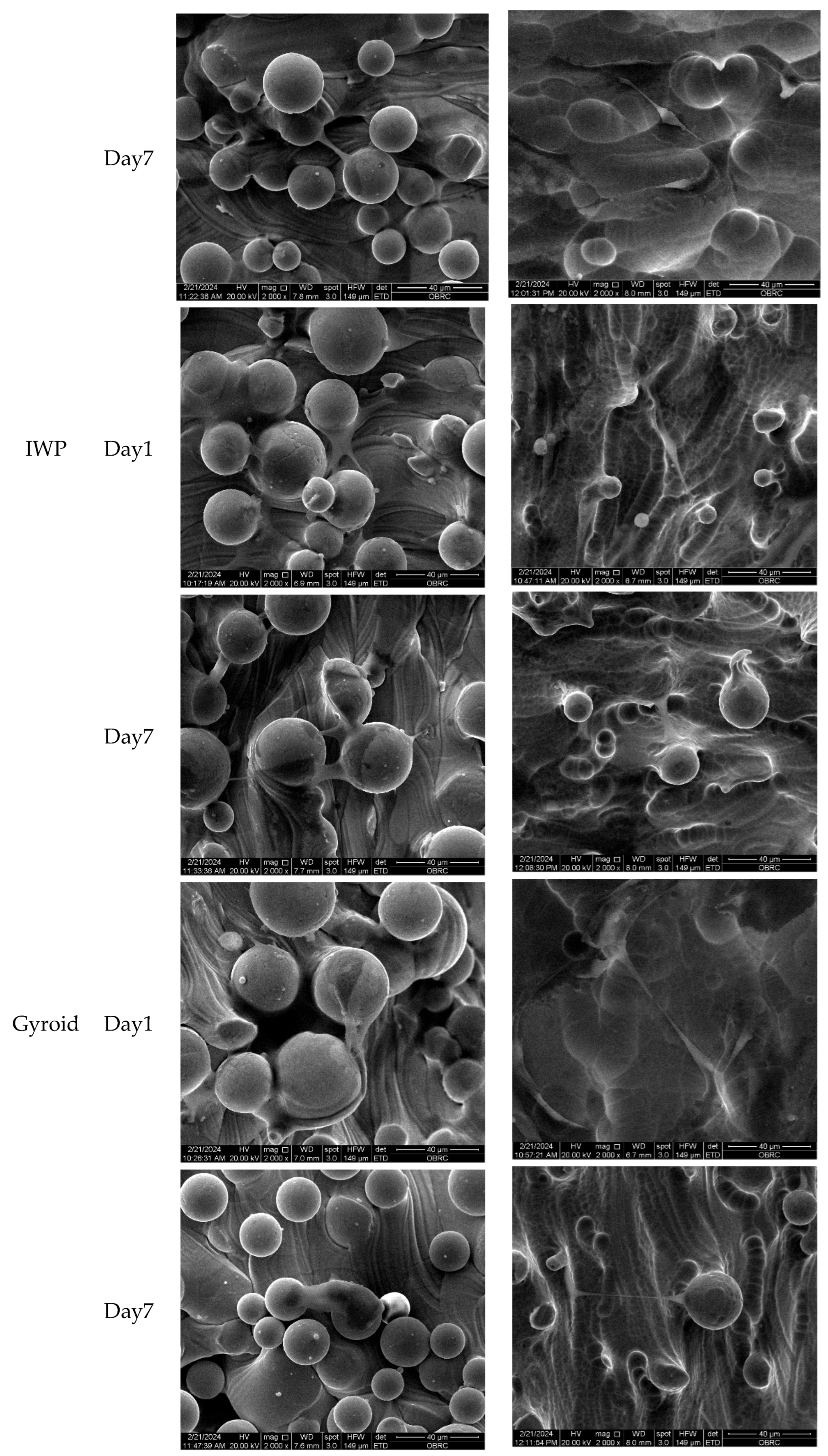

Non-Etching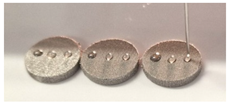 | Etching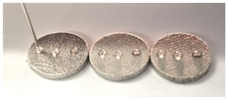 | ||
|---|---|---|---|
| Contact Angle [°] | Diiodomethane | 52.12 ± 0.81 | 55.52 ± 1.79 |
| Ethylene glycol | 71.51 ± 3.63 | 73.65 ± 2.96 | |
| Thiodiglycol | 67.44 ± 2.18 | 71.01 ± 2.17 | |
| Surface Energy (mN/m) | 33.16 | 31.03 | |
| Sample | Pore Size (µm) | Unit Cell Size (µm) | Wall Thickness (µm) | Surface Area (mm2) | Relative Density |
|---|---|---|---|---|---|
| Simple cubic | 600 | 600 | 249 | 1050.73 | 0.33 |
| Gyroid | 600 | 1545 | 130 | 968.15 | 0.30 |
| IWP | 600 | 1228 | 100 | 1373.25 | 0.30 |
| Gene | Primer | Sequences |
|---|---|---|
| bFGF | Forward | 5′ GGC TTC TTC CTG CGC ATC CAC 3′ |
| Reverse | 5′ GGT AAC GGT TAG CAC ACA CTC CT 3′ | |
| CD34 | Forward | 5′ ACCACTAGCACTAGCCTTGC 3′ |
| Reverse | 5′ CCTTCTTAAACTCCGCACAGC 3′ | |
| GAPDH | Forward | 5′ TCATGGGTGTGAACCATGAGAA 3′ |
| Reverse | 5′ GGCATGGACTGTGGTCATGAG 3′ | |
| IDO | Forward | 5′ CATCTGCAAATCGTGACTAAG 3′ |
| Reverse | 5′ GTTGGGTTACATTAACCTTCCTT 3′ | |
| IFN-γ | Forward | 5′ CTA GGC AGC CAA CCT AAG CA 3′ |
| Reverse | 5′ CAG GGT CAC CTG ACA CAT TC 3′ | |
| IL1-β | Forward | 5′ TTCGAGGCACAAGGCACAA 3′ |
| Reverse | 5′ CCATCATTTCACTGGCGAGC 3′ | |
| PDGF | Forward | 5′ TCA GGT GGG TTA GAG ATG GAG T 3′ |
| Reverse | 5′ GAA AGG AAC CAG AGG AAG AGG T 3′ | |
| TNF-α | Forward | 5′ CACAGTGAAGTGCTGGCAAC 3′ |
| Reverse | 5′ ACATTGGGTCCCCCAGGATA 3′ | |
| VEGF | Forward | 5′ ATG AGG ACA CCG GCT CTG ACC A 3′ |
| Reverse | 5′ AGG CTC CTG AAT CTT CCA GGC A 3′ |
Disclaimer/Publisher’s Note: The statements, opinions and data contained in all publications are solely those of the individual author(s) and contributor(s) and not of MDPI and/or the editor(s). MDPI and/or the editor(s) disclaim responsibility for any injury to people or property resulting from any ideas, methods, instructions or products referred to in the content. |
© 2025 by the authors. Licensee MDPI, Basel, Switzerland. This article is an open access article distributed under the terms and conditions of the Creative Commons Attribution (CC BY) license (https://creativecommons.org/licenses/by/4.0/).
Share and Cite
Srimaneepong, V.; Trachoo, V.; Phothichailert, S.; Srithanyarat, S.S.; Mahanonda, R.; Norbert, H.; Khrueaduangkham, S.; Promoppatum, P.; Osathanon, T. Evaluating Surface Properties and Cellular Responses to Surface-Treated Different Triple Periodic Minimal Surface L-PBF Ti6Al4V Lattices for Biomedical Devices. Int. J. Mol. Sci. 2025, 26, 2960. https://doi.org/10.3390/ijms26072960
Srimaneepong V, Trachoo V, Phothichailert S, Srithanyarat SS, Mahanonda R, Norbert H, Khrueaduangkham S, Promoppatum P, Osathanon T. Evaluating Surface Properties and Cellular Responses to Surface-Treated Different Triple Periodic Minimal Surface L-PBF Ti6Al4V Lattices for Biomedical Devices. International Journal of Molecular Sciences. 2025; 26(7):2960. https://doi.org/10.3390/ijms26072960
Chicago/Turabian StyleSrimaneepong, Viritpon, Vorapat Trachoo, Suphalak Phothichailert, Supreda Suphanantachat Srithanyarat, Rangsini Mahanonda, Heil Norbert, Suppakrit Khrueaduangkham, Patcharapit Promoppatum, and Thanaphum Osathanon. 2025. "Evaluating Surface Properties and Cellular Responses to Surface-Treated Different Triple Periodic Minimal Surface L-PBF Ti6Al4V Lattices for Biomedical Devices" International Journal of Molecular Sciences 26, no. 7: 2960. https://doi.org/10.3390/ijms26072960
APA StyleSrimaneepong, V., Trachoo, V., Phothichailert, S., Srithanyarat, S. S., Mahanonda, R., Norbert, H., Khrueaduangkham, S., Promoppatum, P., & Osathanon, T. (2025). Evaluating Surface Properties and Cellular Responses to Surface-Treated Different Triple Periodic Minimal Surface L-PBF Ti6Al4V Lattices for Biomedical Devices. International Journal of Molecular Sciences, 26(7), 2960. https://doi.org/10.3390/ijms26072960






